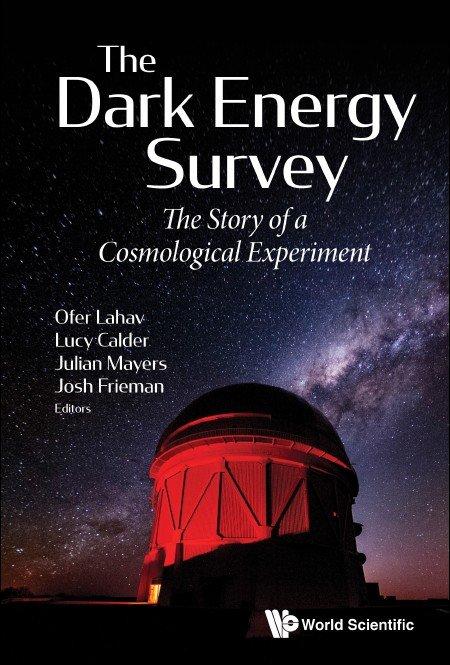The dark energy survey

Credit: World Scientific
How does our universe function? Why is it expanding and why is the expansion accelerating? The advances of recent decades have been astonishing, and following every discovery, big and small, new questions and mysteries have sprung up in their wake. Scientists can now trace cosmic history back to a moment only a tiny fraction of a second after the Big Bang. We are finding out more and more each day about how cosmic structures are emerging and evolving.
The Dark Energy Survey: The Story of a Cosmological Experiment discusses the results and processes behind the Dark Energy Survey (DES), a project which began in 2003, with observations started in 2012 and completed in 2019. The data analysis is still ongoing, involving 300 million galaxies and thousands of supernovae, with the collaboration of several hundred experts from all over the globe.
The purpose of DES was to delve deeper into these new mysteries, investigating the physical nature of dark energy by measuring its effect on the expansion history of the Universe and on the growth of large-scale structure. The survey saw first light in 2012, after nearly a decade of planning, and completed observations in 2019. The collaboration designed and built a 570-megapixel camera and installed it on the four-metre Blanco telescope at the Cerro Tololo Inter-American Observatory in the Chilean Andes. A project of this scale has required the long-term commitment of hundreds of scientists from institutions all over the world, which is why this book is more than just the description of a truly significant experiment.
The Dark Energy Survey is divided into four sections: Building DES, Dark Energy Science, Non-Dark Energy Science, and Reflections & Outlook. While the first three sections present a more science-heavy focus, the last one supplies an interdisciplinary outlook on the subject matter, including perspectives from an anthropologist, a philosopher, and a poet. In almost every chapter the reader is offered a glimpse behind the scenes, to the numerous and diverse set of challenges surrounding the project: its conception, the years of tireless effort to collaborate on a design, the frustrations and tensions between the team members that are inevitable during such an endeavour.
Many of the chapters were written by the scientists who were directly involved, and tell the story of an international cosmology project from the inside. By combining personal accounts with scientific discussions, the reader is given a comprehensive, multidimensional overview of DES. People from all over the world have united and worked together for many years, with the hope and ambition to understand the universe a little better.
Analysis of the early data has confirmed remarkably accurately the model of cold dark matter and a cosmological constant, a specific form of dark energy. Additionally, the survey has offered new insights into galaxies, supernovae, stellar evolution, solar system objects and the nature of gravitational wave events. Further analysis from the survey is underway.
This book is addressed to scientists, decision makers, social scientists, and engineers. It also remains accessible to non-specialists with an interest in scientific discoveries and cosmology.
The Dark Energy Survey retails for US$128 / £115 (hardcover) and is also available in electronic formats. To order or know more about the book, visit http://www.
About the Editors
Ofer Lahav is Perren Chair of Astronomy at University College London (UCL). His research area is Observational Cosmology, in particular probing and characterising dark matter and dark energy. His work also involves Machine Learning for Data Intensive Science. He earned his PhD at the University of Cambridge, where he was later a member of staff. He served as the co-chair of the Science Committee of the Dark Energy Survey from 2007 to 2016 and has led the DES:UK consortium.
Lucy Calder has an MSc in Astrophysics and an MRes in Anthropology from UCL, where she studied the history of dark energy and the Dark Energy Survey. She also holds an MA in Creative Writing from Bath Spa University.
Julian Mayers is a part time cosmologist — researching phenomena associated with astrophysical X-rays. He also is a radio producer and owner of a video production company.
Josh Frieman is a Distinguished Scientist and Head of the Particle Physics Division at Fermilab. He is also Professor of Astronomy and Astrophysics at the University of Chicago, where he is a member of the Kavli Institute for Cosmological Physics. Frieman’s research centres on theoretical and observational cosmology, including studies of the nature of dark energy, the early Universe, gravitational lensing, the large-scale structure of the Universe, and supernovae as cosmological distance indicators. He served as the Director of the Dark Energy Survey from 2010 to 2018.
About World Scientific Publishing Co.
World Scientific Publishing is a leading international independent publisher of books and journals for the scholarly, research and professional communities. World Scientific collaborates with prestigious organisations like the Nobel Foundation and US National Academies Press to bring high quality academic and professional content to researchers and academics worldwide. The company publishes about 600 books and over 140 journals in various fields annually. To find out more about World Scientific, please visit http://www.
###
Media Contact
Andreea Zaharia
[email protected]
Original Source
https:/




